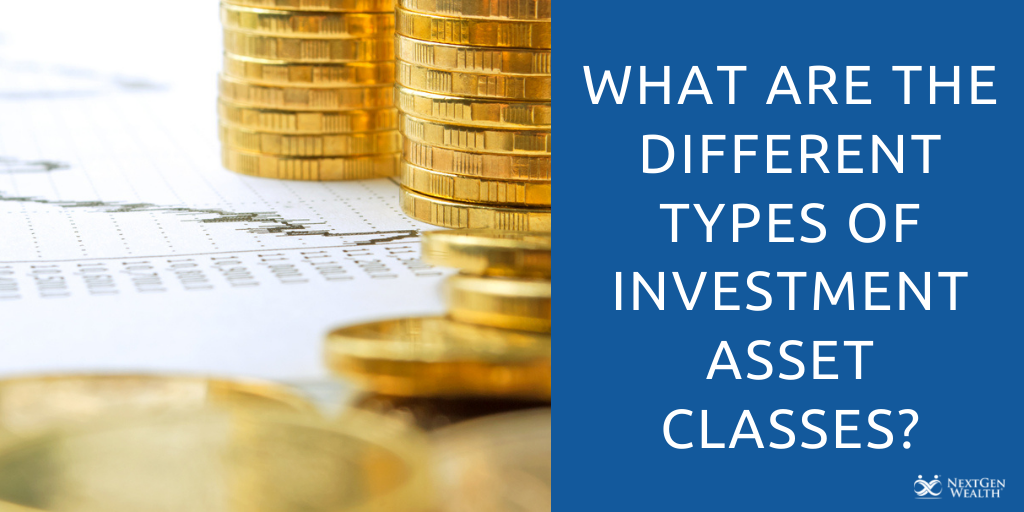What Are the Different Types of Investment Asset Classes?
Many investors consider diverse investment portfolios desirable because they reduce the overall risk inherent to investing. One of the primary ways to diversify your portfolio is to invest in different asset classes. Before you can do that, though, you need to know a little more about what they are. 
While even the most diverse investment portfolios aren’t immune to risk entirely, risk reduction of any amount can help provide you with peace of mind, particularly when you’re investing as a way to support yourself through retirement.
NextGen Wealth is here to provide you with the information and support you need to make sound investments, which is why we have put together this straightforward guide to the different investment asset classes you’re likely to encounter.
What Are Asset Classes?
Asset classes are groups of investments. They have many of the same characteristics, and the same rules and laws regulate them.
Okay, you might be thinking. None of those words mean anything, but alright.
I agree. That definition is too vague to be useful for most of us, but it’s as good as it gets until we start introducing real-life examples.
The best way to think about an asset class is as a broad category you can use to describe an investment. Maybe you just bought stock in Chevron or purchased a $500 treasury bond. Both of those activities are investments, but they’re hardly comparable.
That’s because they belong to different asset classes.
Traditional Investment Asset Classes
While the finance industry is dynamic, some things have been around for years without much change. The three traditionally recognized asset classes are the most well-known investment methods, although you’re by no means limited to them.
These asset classes are stocks, bonds, and cash equivalents. Each has its own merits and risks.
Stocks
Stocks may be the most well-known of all the investment asset classes due to the market’s volatility. Any time the stock market has an exceptionally good or bad day, news coverage abounds. Apps like Robinhood and Stockpile make investing in stocks more accessible, so many people gain personal investing experience.
Sometimes called equities, stocks represent the money you would receive if the company whose stock you hold were to liquidate all of its assets and return the funds to you and your fellow shareholders.
Now, the likelihood of that happening is slim to none. However, as our economy continues to grow, a stock’s value increases.
Let’s say you purchase $100 worth of stock. The market does well, and a while later, that same amount of stock is worth $150. If you choose to sell it, you pocket a $50 profit.
Some stocks will also pay dividends, meaning that a company will send some of the money it made to its shareholders. Continuing with the same numbers from our last example, let’s say you own $100 worth of stock in a company. If that company has an annual dividend yield of five percent, you’ll make five dollars from a dividend payment for that stock over a year.
Many investors have far more than $100 in the stock market, meaning their profits are exponentially higher than those discussed in our examples. However, micro-investing is an option for casual investors or those looking to learn more about the process through firsthand experience.
Bonds
Bonds or fixed-income investments, are another of the traditional investment asset classes. You’re likely to encounter five different types when you’re investing in bonds:
- Government-issued securities like treasury bonds.
- Corporate-issued securities, also called corporate bonds, which is debt sold by a company to raise funds.
- Inflation-protected securities protect investors from a decline in the value of the dollar.
- Mortgage-backed securities, which were made infamous by the 2007-2008 subprime mortgage meltdown.
- Asset-backed securities, which generally take advantage of cash flow created by debts.
Government-issued securities from the U.S. government are generally considered risk-free, the idea being that the government will pay you back with interest no matter what. Investors typically consider securities issued by some foreign governments a little riskier because they may default on the bond.
While risk-free and low-risk investments are appealing to investors, the downside to government-issued securities is that interest rates are low. Your investment might be nearly risk-free, but if the interest rate on a bond doesn’t keep up with the rate of inflation, you’re missing out on potential profits.
The other four bond types listed above operate similarly to one another. They’re higher risk than government-issued securities because the risk of default is higher, as the 2008 mortgage crisis proved.
We all hope that 2008 was a once-in-a-lifetime meltdown and have learned a great deal from it. Two of the primary takeaways are the importance of diversification and accurate risk assessment.
Cash Equivalents
Cash, cash equivalents, and money market instruments are discussed less frequently than stocks and bonds, but they’re essential to understanding some of the financial decisions companies make.
This asset class is made up of highly liquid securities meant for short-term investing. It includes:
- T-bills, from the U.S. government, are a form of security that doesn’t pay interest but is sold at a discounted price.
- Corporate commercial paper helps companies meet short-term financial obligations with the promise of paying investors back later.
- Bankers’ acceptances are promises of a payment from a bank at a later date.
- Bank certificates of deposit offer investors interest in exchange for leaving a sum of money untouched for a certain period.
Cash equivalents are similar to bonds in that they tend to be low-risk and low reward, but they do help diversify an investment portfolio.
The most exciting part of cash equivalents is what they can tell you about a company that is storing an unusually high percentage of its capital in them. The presence of more cash equivalents may indicate that:
- The company in question is using them to cover their day-to-day operating costs.
- The company suspects that lean economic times may be on the horizon and wants the ability to liquidate their assets quickly if it becomes necessary.
- The company is getting ready to make an acquisition.
While the presence or absence of cash equivalents isn’t the only variable you should rely on when making investment decisions, it’s certainly worth tracking.
If you’re interested, cash equivalents are visible on the top line of a company’s balance sheet because they’re among the company’s most liquid assets.
Alternative Investment Asset Classes
While stocks, bonds, and cash equivalents are the traditional asset classes, today’s investors recognize others. Some of these alternative asset classes, like real estate and commodities, are more tangible than the traditional options. Others, such as futures, may feel very distant.
You may never interact with one of the asset classes we’re about to talk about, or you may find that they’re very profitable options for you. It will depend on your circumstances and preferences.
Real Estate
Investing in real estate can be as hands-on or as hands-off as you want. Real estate can be expensive to begin investing in, but many people find it rewarding.
If you’re interested in physically working with your investment, you may want to buy and flip houses. If this is the path you take, you will either buy a property and fix it up or buy it and hold onto it until housing prices rise sufficiently to make it worth your while to sell.
An equally physical but more long-term option is to purchase a property and become a landlord. You may choose to hire a property manager or take on the role yourself. While potentially lucrative, this option is more involved than most people looking to invest prefer.
For the hands-off investor, there are a collection of acronyms you might be interested in, including:
- Real estate investment trusts (REITs), which you can invest in on most major exchanges. They operate a little like a dividend-paying stock.
- Real estate investment groups (REIGs) offer all of the benefits of owning a rental property with very few of the drawbacks.
- Real estate limited partnerships (RELPs) function nearly identically to REIGs, but they’re sold to generate profit at the end of a predetermined period rather than held onto.
Real estate mutual funds have a lower financial barrier to entry for more casual or smaller investors. A real estate mutual fund will invest in multiple REITs, allowing you to enjoy a more diverse portfolio.
Commodities
Commodities are raw materials. They come in two primary forms: hard and soft.
Hard commodities tend to be natural resources like wood, fossil fuels, and different metals. Soft commodities can’t be stored for as long. Agricultural commodities like livestock, cotton, and various cash crops are considered soft commodities.
The two main benefits of investing in commodities are a more diverse portfolio and protection from inflation.
Commodities are more tangible than other asset classes like stocks and bonds, meaning that they will react differently in different market situations. They also tend to become more valuable due to inflation, directly contrasting with most other asset classes.
When goods and services are more expensive due to high demand, the commodities necessary to produce them are worth more. For investors looking to mitigate the impact of inflation, this can be valuable.
Futures
Futures are one of the more difficult asset classes to understand because they involve two different parties, and they’re a derivative, meaning their value is derived from another asset. They also overlap with other asset classes, which can be confusing.
Futures you might hear about or see traded include:
- Commodity futures like natural gas or crude oil.
- Futures for bonds from the U.S. Treasury.
- Currency futures.
- Stock index futures, the most well-known example of which is the S&P 500.
Futures are risky investments. Of all the asset classes, they might feel the most like gambling to you.
In a futures contact, a buyer and seller agree on a price for a commodity or another type of asset. They agree to make the sale at an agreed-upon point in the future, hence the name.
The risk for the buyer is that market prices will be much lower than the price they agreed to purchase the asset or commodity for. It’s the reverse for the seller, who risks the market price of whatever they’re selling being much higher than what they agreed to.
Other Financial Derivatives
Numerous other financial derivatives are available, and more are created every year. Right now, cryptocurrencies are the most newsworthy of them.
Investing in a new financial derivative is risky. Bitcoin, the most well-known of the cryptocurrencies at the moment, proves that. In the past year alone, the value of a single Bitcoin has gone from around $9,000 to nearly $60,000.
Bitcoin has only been around since 2009, so there’s no precedent for what might happen next. That’s enough to make a lot of investors nervous.
Which Asset Class Is Best?
After taking in all of the information we’ve covered today, you’re probably wondering which asset class is best. The answer to that question is either that it depends or that there isn’t one that’s better than the others. That’s frustrating, I know.
If you’re looking for the asset class with the highest general rate of return, it’s probably the stock market. However, that’s also one of the riskiest options out of the traditional asset classes.
Bonds are outstanding in terms of risk, but their returns can be uninspiring. Cash equivalents are the same but on a shorter time scale.
Real estate investing can be labor-intensive. Commodities require a broad understanding of various industries.
Futures and other financial derivatives can confuse new investors and pose more significant risks for everyone involved.
Faced with the potentially overwhelming list of variables you need to weigh while you invest, where do you turn for trusted advice and information? If you’re in need of investing help, consider connecting with NextGen Wealth. We believe in putting your interests and well-being first.
To learn more about what we can do for you or take advantage of our free financial assessment, contact NextGen Wealth today.


